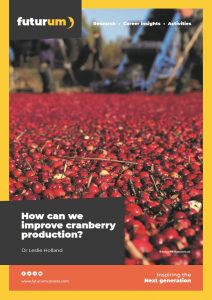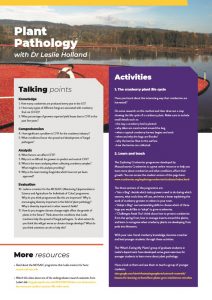How can we improve cranberry production?
Indigenous Peoples have been using cranberries in food, medicine and fabric dye from as early as the 1500s, and these fruits are still widely used and produced across the US today. However, fruit rot diseases can cause tremendous damage to these plants, leading to substantial yield losses if they are not properly managed. At the University of Wisconsin-Madison in the US, Dr Leslie Holland is a plant pathologist working to understand fruit rot and how we can better protect cranberries.
Talk like a plant pathologist
Bogs or marshes — the farms where cranberries grow in beds. In the northeast US, they say ‘bog’ and in the midwest, ‘marsh’
Cranberry beds — the individual production units for cranberries; usually, one bed contains a single variety
Cranberry fruit rot (CFR) — a disease complex, caused by fungi, that impacts the quality of cranberry fruit
Fungi — organisms that get their food from decomposing organic matter or other living things, the plural of fungus
Fungicide — products used to kill or prevent the growth of pathogenic fungi
Pathogen — an organism that causes disease, such as bacteria, viruses, fungi or parasites
Pathology — the science of the causes and effects of diseases
Yield — the amount produced of an agricultural or industrial product
At the University of Wisconsin- Madison, Dr Leslie Holland is studying cranberries and the diseases that affect them. Cranberries are native to North America and grow best in the climates of the northern US states and southern Canadian provinces. The US is leading the world in the production of cranberries – according to Statista, around 403,000 tons of cranberries were produced there in 2022!
However, when Leslie’s research team surveyed growers in the US, 83% of them said that cranberry fruit rot (CFR) had caused them to lose fruit in the last five years. “CFR is the main factor reducing yields of cranberry in the US,” explains Leslie. When a cranberry is infected by fruit rot fungi, the fruit quality is greatly reduced, often meaning that the fruit is unable to be sold.
What causes cranberry fruit rot?
There are at least 15 fungal species associated with CFR. “These pathogens infect developing plants during bloom, then remain inactive until fruit begins to mature and rot symptoms develop,” explains Leslie.
Each of these 15 pathogens might have unique characteristics and life cycles, their own method of surviving varying conditions, and their own resistance to different fungicides. “Managing multiple fungal species simultaneously can be complex and requires a tailored approach,” says Leslie.
Cranberry beds – where cranberries are grown – also provide convenient environments for fungi to grow in, making it difficult for cranberry growers to keep on top of controlling fruit rot. Environmental conditions, such as heat and humidity, affect the development of CFR fungi too. This is similar to how fungal pathogens work on humans. Have you ever heard of athlete’s foot, a common skin infection caused by a fungal pathogen, that causes extremely itchy feet?
Sweaty and damp socks and shoes, and any other warm, humid conditions, help this fungal pathogen to grow. These conditions are the same ones which help the fungi affecting cranberries to grow. “High humidity, prolonged leaf wetness, and warm temperatures favour the development and spread of fungal pathogens,” explains Leslie. This means that if a summer is particularly wet or warm, the disease can be even more of a problem for growers. Fungi can also survive from season to season; if CFR affects a plant one year, the pathogens might still survive in the leaves and last season’s plant tissue to infect the following year’s fruit as well.
What else makes CFR such a challenge?
The challenge of controlling fruit rot is made even more difficult because of the delay between when fruit gets infected and when symptoms of the rot start showing. “Infections occur early in the season, while visible signs of the disease show up later,” says Leslie. This means that several pathogens can be present within the cranberry plants, but growers have no idea of the problem until it is too late. “This adds complexity to managing fruit rot since understanding the factors triggering rot development becomes crucial, particularly in situations where the fungi are present, but the plants are not actively showing symptoms,” Leslie adds.
To combat these issues, Leslie has developed a research project called S.A.M.E. (Systems Approach for Managing the Expression) of Cranberry Fruit Rot. Her team is aiming to understand more about CFR fungi, how CFR can be prevented, how growers can recognise it, and how they can better protect their cranberries in the future.
S.A.M.E. of CFR
Leslie’s research project is focusing on five major cranberry-producing states across the US: Wisconsin, New Jersey, Massachusetts, Oregon and Washington.
Cranberries grow on low-lying vines in levelled soil beds, commonly referred to as bogs or marshes. These plants have small shoots which flower and, eventually, turn into cranberry fruits. Leslie and the rest of the project team collect samples from two popular cranberry varieties at different plant developmental stages, such as when the shoots are flowering and when they change into berries. The researchers take all these samples back to the laboratory to identify which fruit rot fungi are growing on the plants and how frequently they appear. “This work will provide valuable insights into the biology of these fungi and contribute to our understanding of how rot develops in the field,” explains Leslie.
Once they have analysed the samples, Leslie and her team evaluate fungicides to understand how fruit rot fungi responds to these chemical products. The fungi’s response can vary between being sensitive to the product, meaning that the fungicide is able to kill off the fungi, to being resistant, meaning that they can continue to survive.
Reference
https://doi.org/10.33424/FUTURUM438
Colletotrichum sp. (pink fungus), one of the principal fruit rot pathogens, growing from a rotten cranberry fruit incubated on culture medium in the lab.
© Leslie Holland, UW-Madison.
Cranberry flowers, the main infection site for fruit rot fungi.
© Leslie Holland, UW-Madison.
© Holland Lab, UW-Madison.
© Leslie Holland, UW-Madison.
The team conducts these tests with a range of fungicides including ones which are already approved as viable products for controlling CFR, as well as ones that are still waiting to be approved. “Since there are limited control options for CFR, exploring the efficacy of new products allows us to potentially expand our toolkit of control measures,” says Leslie.
What has the team found so far?
The team has discovered that the species of fungi present in cranberries varies depending on where the cranberries are growing. This might be due to differences in climate between these regions, which is allowing some types of fungi to grow better than others.
Leslie’s goal is to eventually develop a disease risk model that will help manage CFR and can be distributed to growers throughout the US. “Currently, there are no reliable ways to predict and manage CFR,” says Leslie. The model will take into account what type of fungicide growers should use based on the specific conditions on each farm, environmental factors and which type of fungus is present in the field. The team also wants to include information around the role of plant stress in developing fruit rot infections, which cranberry varieties are more resistant to CFR, and the pros and cons of different management strategies.
The S.A.M.E. of Cranberry Fruit Rot project is still in the early stages of its work, and Leslie is excited to see what comes next.
 Dr Leslie Holland
Dr Leslie Holland
Holland Lab, University of Wisconsin-Madison, USA
Field of research: Plant Pathology
Research project: Developing a S.A.M.E. (systems approach for managing the expression) of cranberry fruit rot
Funders: US Department of Agriculture (USDA), National Institute of Food and Agriculture (NIFA)
This work is supported by the USDA National Institute of Food and Agriculture Specialty Crop Research Initiative Award No. 2022-51181-38322. The contents are solely the responsibility of the authors and do not necessarily represent the official views of the USDA.
Leslie’s research involves an interdisciplinary team. Her co-investigators are:

Top row, left to right: Dr Amaya Atucha of the University of Wisconsin-Madison, Dr Jeffrey Neyhart and Dr Virginia Stockwell of the US Dept of Agriculture, Dr Peter Oudemans of Rutgers University and Dr Leela Uppala of the University of Massachusetts Amherst
Bottom row, left to right: Dr Peter Jeranyama, Dr Jill Fitzsimmons and Dr Giverson Mupambi of the University of Massachusetts Amherst, Dr Juan Zalapa and Dr Jyostna Mura of the US Dept of Agriculture and University of Wisconsin Madison
About plant pathology
Plant pathologists are effectively plant doctors. It is their job to study plant diseases and devise new, effective methods for treating and managing diseases. “Figuring out what causes these diseases, finding fast ways to detect them, and coming up with ways to manage them are crucial areas to pursue in plant pathology,” says Leslie. Plant pathology combines many different areas of expertise, including genetics, epidemiology, food security, physiology and molecular biology, and it often takes an interdisciplinary approach to solve issues.
Climate change has a huge influence on plant pathology, as changes in weather and environment affect the frequency, distribution and severity of plant diseases. “New plant diseases are emerging, and existing diseases are spreading to new regions where they have not been seen before. Understanding how environmental factors impact diseases and how plants interact with pathogens can help us deal with disease outbreaks associated with a changing climate,” explains Leslie.
Plant pathologists now have more cutting-edge technology available to them, and advanced techniques such as remote sensing are becoming more important for managing plant diseases. “There are numerous exciting opportunities for the next generation of plant pathologists!” says Leslie.
Why is diversity important in this field?
Leslie is a mentor for the MOSAIC (Mentoring Opportunities in Science and Agriculture for Individuals of Color) programme at the University of Wisconsin-Madison, which is a support system for people of colour on campus. “Initiatives like MOSAIC are very important for fostering connections, especially in predominantly white institutions, where persons of colour may have fewer opportunities to engage and feel included,” says Leslie. With the goal of combatting social isolation, the programme connects students of colour with staff of colour. “By encouraging and empowering students of colour to pursue careers in these fields, the programme helps to address the underrepresentation of diverse voices and perspectives.”
Pathway from school to plant pathology
• During high school and post-16 years, study chemistry and biology, as well as any gardening or plant-based courses that
your school or college might offer.
• Reach out to your local botanical garden or horticultural society to see if you can get some hands-on experience.
• Study a bachelor’s degree in plant pathology or a relevant field such as molecular biology, plant science, botany or
agriculture. “If you want to learn and do research in this field, it’s helpful to have knowledge in various subjects,” says Leslie. “Classes often include biology, chemistry, statistics, agricultural sciences (such as agronomy or horticulture), microbiology, botany, genetics, plant pathology, plant physiology and research methods.”
• “Summer internships are a great way to gain hands-on experience and provide opportunities to connect with other scientists in career fields that may interest you,” says Leslie. Have a look for practical experience such as research projects or work in plant pathology laboratories or research farms.
• Leslie’s lab sometimes hires undergraduates or recent graduates for summer positions.
Explore careers in plant pathology
• One of the best websites to explore plant pathology is the American Phytopathological Society (APS).
“APS hosts national conferences annually and collaborates with other phytopathological societies around the world, including the British Society for Plant Pathology and the International Society for Plant Pathology,” says Leslie. The APS website also has a brilliant careers page which gives information on what plant pathologists do and what qualifications and experience you need to get into the field.
• Listen to this great 25-minute podcast by Plantopia where Leslie talks to other plant pathologists about cranberry fruit rot. Another episode covers different careers in plant pathology.
• Graduate students in Leslie’s department have formed a group called WEMP (What’s Eating My Plants), with the aim of educating people about the role plant pathology plays in our lives. Visit the group’s website.
• According to Federal Pay, the average annual salary for a plant pathologist in the US is $118,000.
Meet Leslie
My high school biology teacher inspired me to become a scientist. She was a great instructor and made the classroom an engaging experience. For me, biology was filled with exciting research questions and hypothesis testing, which inspired me to pursue a career in science. This led me to choose a career in research where I not only get to ask questions but can also find answers through my own research, and that has been an incredibly rewarding journey for me.
Participating in conferences and interacting with fellow scientists has been a valuable experience that has helped me grow as a scientist. Equally important has been the influence of supportive mentors who guide and promote my work and create an environment conducive to success.
One of my most memorable eureka moments occurred during my first research talk to an audience of growers. Unlike presenting to a group of fellow scientists, this audience had a different perspective and set of questions. They were highly focused on understanding the real-world implications of my findings, not just the theoretical aspects. This experience was eye-opening, as it made me realise the significance of translating scientific knowledge into practical applications. Until then, my focus had been mainly on lab experiments and field trials, but this moment highlighted the importance of bridging the gap between research and its practical implementation.
The worst piece of advice I’ve received is to unquestionably trust research already published in scientific literature. However, my journey as a scientist has taught me to unlearn this, as scientific theories, approaches and hypotheses can (and do) change over time. This is one of the most exciting things about science because advancements in technology and knowledge constantly shape our understanding. This doesn’t mean that older studies are invalid; in fact, these studies provide the foundation from which we can expand our knowledge and explore new questions with the latest techniques and insights.
My most significant career accomplishments to date include completing my graduate studies and landing my dream job as an Assistant Professor and Extension Specialist specialising in fruit crop pathology. Since college, I wanted to become a ‘plant doctor’, to study plant diseases and share knowledge with growers. Most recently, I was selected as the Researcher of the Year from the Wisconsin State Cranberry Growers Association. This recognition is a great honour, as it acknowledges the hard work and contributions my research lab has made in supporting the cranberry industry.
My main goal for the future is to become a leader in the field of plant pathology, focusing on making meaningful contributions in the areas of cranberry fruit rot biology and management. As the principal investigator of my lab, I am committed to fostering a collaborative and supportive environment for all the students and staff involved. One of the most fulfilling aspects of my job is helping students recognise their full potential and guiding them as they progress in their academic and professional journeys.
Leslie’s top tips
1. Take opportunities to explore different paths and interests. Learning what you do not enjoy doing is just as valuable as learning about the things you do enjoy.
2. While there are always new things to learn in the classroom, don’t hesitate to get outside and get your hands dirty.
3. Don’t be discouraged if you don’t see many people that look or sound like you in the field you want to pursue. Your unique perspective can bring positive change and innovation to any field.
Do you have a question for Leslie?
Write it in the comments box below and Leslie will get back to you. (Remember, researchers are very busy people, so you may have to wait a few days.)







